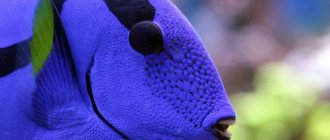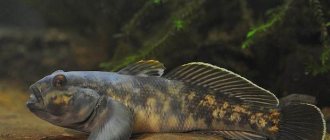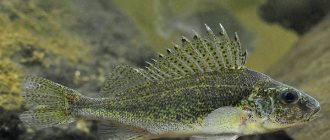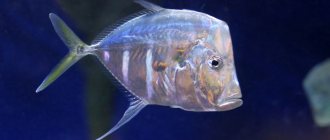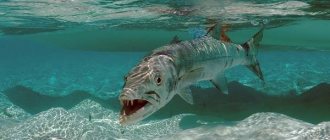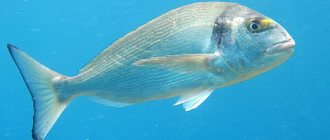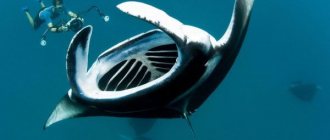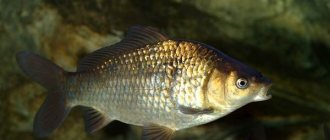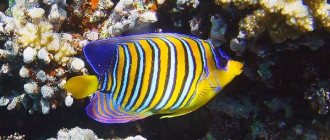The ocean depths have been fraught with many mysteries since ancient times. Animals that inhabit this mysterious world often have a terrifying appearance and unusual behavioral habits. From the list of these unique creatures, one cannot ignore the flashlight fish from the ray-finned genus, which has an incredibly repulsive appearance. Due to their deep-sea habitation, monsters are little known to science, although they have lived on Earth for one hundred million years.
Have you ever met a fish with a flashlight?
Yes
0%
No
100%
Voted: 3
What is the name of
The name from English is translated as “fisherman”, which is explained by the specific fishing rod in the head of exotics; they are also called anglers, thanks to the same organ. The monster also bears the name of the monkfish or the devil, which is how the sailors christened it when they first caught the monster, who appeared as if from the underworld itself. The representative of the anglerfish family looks really ugly:
- The spherical body of a horizontally flattened format is folded disproportionately - the huge head occupies 70% of the body, the remaining percentage is allocated to the small tail.
- The narrow eyes are close-set.
- The skin has no scales; it is covered with numerous bumps, skin and bone growths similar to moss, needles, and warts. The top is all covered with mucus.
- In the mouth there is a palisade of 2-3 rows of sharp, but weak teeth, bent inward.
- The lower jaw is characterized by inactivity and protrusion forward.
The ridge is brown with splashes of green or red. The entire surface is dotted with dark and light spots, and the abdomen is white. On the ray extending from the first fin on the back there is a rod with a light, which the owner will turn on as needed. In different types, the luminous lantern can be located not only on the head, but also in the mouth area or hidden in the back after use. In gigantaxis, this adaptation exceeds their own length by several times.
Predatory individuals reach sizes from half a meter to two meters, their weight is on average 20 kg, but there are also 60-kg giants.
Long-snouted seahorse
The horse is a predator, eating small crustaceans, invertebrate animals, larvae and fry.
Having no teeth, skates suck the prey whole, but do not digest it, since they do not have a stomach.
The miniature sea creature can glow in different colors: its body emits a red glow, and around its eyes there is a green glow. Light serves as camouflage, helping the skate to adapt to the color of its environment.
Varieties
Species differences lie in size, weight, depth of residence, and appearance. The main types are presented:
- American;
- gray black-bellied;
- European;
- Western Atlantic;
- Far Eastern;
- South African;
- endangered Cape subspecies.
“Americans” are long-livers, living up to 30 years; the rest of their “brothers” have a much shorter lifespan. The predator occupies the top of the food chain, but can suffer from giant squid, octopuses, dragon fish, and the “hell dragon” mollusk. The population is declining sharply due to human fishing activities. The deep dweller is caught with bottom trawls and specialized gear.
The boneless meat of the terrible monkfish is highly valued for its excellent taste and healthy composition, and this only applies to the tail. Liver, rich in B vitamins, iron, phosphorus, and iodine, is especially in demand.
Where does the angler fish live?
The condition for the best use of luminous bait when hunting is the absence of sunlight. Therefore, the anglerfish climbs deeper into the ocean water, at a depth of one and a half to 3 kilometers.
The predator is widespread in the Atlantic and Indian oceans and prefers cool water. Thanks to underwater currents, fish can even end up in the subarctic or subantarctic zone. Different species of anglerfish have different habitats.
The black-bellied anglerfish is found in the eastern part of the Atlantic and sometimes swims into the Mediterranean and Black Sea. Its Western Atlantic relative, distinguished by a more modest size of up to 60 centimeters, was named after its habitat. In approximately the same region, but closer to the north, you can find the American anglerfish. The European representative of this suborder of ray-finned fish occupied the waters of the seas washing the western part of Eurasia: the Barents, Baltic, North and Black Seas. The Far Eastern anglerfish is one of the largest representatives of this fish species. Its population is widespread in the Sea of Japan, on the Pacific coast, and off the coast of Korea. The Burmese anglerfish is also named after its habitat. It can be distinguished by its shorter tail.
Why a flashlight?
The lantern above the upper jaw of the illicium looks like a growth ending at the end with a sac filled with luminous bacteria produced by a special gland. The brightness and intensity of the glow is regulated by the owner due to the expansion and contraction of blood vessels, which provokes the flow of oxygen to the esophagus, or stops this process if unnecessary. When the darkness is illuminated by flashing flashes of light, it attracts curious fish.
Small creatures not exceeding 20 cm also have a similar structure:
- bat;
- clown fish.
They can be successfully bred in a home aquarium. Moving the fishing rod like bait, turning on the light bulb, the hunters sit in ambush for a long time. They blend into the environment and do not breathe for 2-3 minutes, and when prey approaches, they suck it in with lightning speed with their toothed mouth. This is possible due to the streams of liquid released by the gills and similar to a whirlpool.
The origin of the fluorescent substance is being studied by scientists; according to one theory, this property is inherited genetically, according to the second, it is acquired during life.
Other fish also use the method of illumination in pitch darkness; for some, the light comes from below, blurring the silhouette, which disorients the enemies.
Yandex picture
Purpose of the lantern
In deep water there is a constant struggle for the survival of ocean inhabitants. Living conditions are unfavorable for most of them - it is cold, dark, very high pressure, lack of oxygen and food. Small fish try to hide well from predators for whom they become prey.
To catch its prey, the monkfish turns on a flashlight, which is located at the end of its fin. This growth, similar to a fishing rod, is called illicia. The lantern is a leathery sac that contains a special type of mucus inside. Specific luminescent bacteria are also found here. The fish knows how to control the luminous sac, turning the light on and off due to the expansion and contraction of blood vessels. During the compression of the blood vessels, the luminescent bacteria experience a lack of oxygen, which normally enters the sac along with the blood; as a result, the light at the end of the rod turns off.
And when the blood vessels dilate, the opposite effect occurs - the light turns on. In appearance, it looks like Morse code, which consists of long and short flashes. To lure its victims, the anglerfish hides at the bottom of the ocean, merging with silt and aquatic vegetation. Then he turns on the light. This flashing attracts schools of small fish that swim past. They begin to swim towards the glow, as a result the predator captures them in its mouth, squeezing it like a trap. All these actions take place in a matter of seconds; the fish have no chance of escaping from the mouth of the glowing monster. By turning on the light, the fish attracts not only fish, but also mollusks, crustaceans and other aquatic inhabitants.
This is a very voracious predator. Its diet may include prey that is several times larger and longer than monkfish. The walls of his stomach are very elastic, due to which he can stretch greatly. If the anglerfish's prey is very large, it can choke on it and die, since it is clamped in the mouth by a strong trap, so the fish cannot spit it out if desired. Sharp and inwardly curved teeth also tightly clamp the victim, not giving it a chance to escape and survive. The diet of monkfish is varied. This type of fish readily consumes the following aquatic inhabitants:
When these fish begin their spawning period, they begin to rise from the seabed, settling in the upper layers of ocean waters. During this period, active weight gain occurs. Cases have been recorded when anglers, with the help of fins and tails, were able to jump out of the thickness of the upper balls of water in order to grab seabirds; as a result, they died because they were unable to digest their prey.
A process with a leathery sac that glows is located in different parts of the body, depending on the type of fish. Some control it and even know how to hide it in their body so that it does not interfere with their free movement. And in other species the illicium is located in the mouth; they can also hide it if desired, and when necessary, pull it out again.
What does it eat?
Closer to the surface, predatory fish hunt mackerel and herring. Their diet is also replenished:
- Stingrays.
- Katranami.
- Flounder.
- Cuttlefish.
- Small squids.
- Acne.
The stomach of the specimens has the ability to stretch, so it is not difficult for them to swallow large prey. This is facilitated by the presence of flexible and thin jaw bones. Due to poor eyesight, the monsters attack sea creatures twice their own size and choke, because the reverse-directed teeth do not give them a chance to spit out their food. The same reaction is guaranteed by swallowing birds sitting on the surface of the water, whose feathers cause suffocation.
Devils are very voracious; according to fishermen, a specimen caught in a net eats the entire catch. There are known cases of cannibalism towards their own kind.
Yandex picture
firefly squid
This species of marine mammal lives in the Pacific Ocean. The mollusk has many photophores throughout the body, especially large ones located on the tentacles. It is them that he “turns on” when he hunts.
The deep-sea inhabitant lives in the water column all day, and rises at night to hunt. It uses light to attract mates, hunt, camouflage, and scare away predatory fish.
During the mating season, the squid uses all its luminous organs. The surface of the water looks amazingly beautiful when schools of squid rise, emitting a bright bluish glow.
Brazilian shark
One of the smallest (only 55 cm) and most aggressive shark species. She is not afraid to attack animals that are larger than her.
Over the course of its entire life, a Brazilian shark changes its teeth 15 times, and eats the ones that fall out.
Thanks to its thick suction lips, it attaches itself to the victim’s body and tears out large pieces of meat from it. The powerful green light emitted by its entire body makes the predator invisible to other animals against the background of the waves.
I love to fish and know how to cook it deliciously, I want to share this knowledge.
Source
Glowing creatures, part 1
Ctenophora
On the body of each of these representatives of the type of marine invertebrate animals there are peculiar ridges, which are bundles of cilia glued together.
The sizes of these creatures are very diverse. Some ctenophores do not exceed 2.5 mm, while others can grow up to 3 m, such as the Belt of Venus (lat. Cestum Veneris).
The body of these creatures resembles a pouch, at one end of which there is a mouth opening, and at the other – the balance organs. Ctenophores do not have stinging cells, so they capture prey with their mouths or trapping tentacles, which are present in representatives of the class Tentaculata.
Their diet is based on fish fry, plankton, as well as their relatives - other ctenophores.
Ctenophores living near the surface of the water are usually transparent and colorless. Deep-sea species, on the contrary, have bright pigmentation (for example, the not yet classified species “red Tortuga”. Platyktenids are often attached to other benthic organisms and have a similar coloration to them. The coelenteron of representatives of the deep-sea genus has a bright red color: this neutralizes the luminescence of copepods absorbed by the ctenophores.
The ciliated ridges of planktonic forms create a rainbow-like appearance caused not by luminescence, but by the refraction of light on vibrating cilia. However, almost all ctenophores are capable of bioluminescence, but the light thus emitted has a blue or green tint and is visible only in the dark.
European anglerfish
Predatory fish of the order Anglerfishes. Also called "monkfish", due to its very unattractive appearance.
The fish is edible. The meat is white, dense, boneless. Monkfish is especially popular in France.
Distributed in the Atlantic Ocean off the coast of Europe from Iceland and the Barents Sea to the Gulf of Guinea and the Black Sea, the North Sea, the English Channel, and the Baltic Sea. Lives at a depth of 18-550 m.
Sea feathers (Pennatulacea)
The glow that it emits is simply a reaction to a variety of stimuli.
You can meet the sea pen in the tropical and subtropical waters of the Mediterranean Sea and the Atlantic Ocean. These creatures settle in colonies on muddy or sandy bottoms. Their diet is based on plankton and organic matter. Sea feathers can grow up to 40 cm.
However, the part of their body exposed above the surface of the water does not, as a rule, exceed 20 cm.
Nutrition
Mainly, other, usually smaller, fish serve as food for these fish. The monkfish menu consists of Katrans, Silversides, Kalkans, Stingrays and others.
In general, the monkfish is incredibly voracious and therefore boldly rushes even at a seemingly obviously unattainable goal. And in “hungry” moments, a large anglerfish, suffering from an almost complete lack of vision, rises to the upper layers of water from the depths and at such moments it is capable of attacking scuba divers.
You can meet such an inhabitant of the deep sea just at the end of summer, after a grueling hungry spawning, the “devils” go to shallow water, where they eat intensively until the fall, after which they go to wintering in greater depths.
However, compared to sharks, barracudas and octopuses, true sea devils or anglerfish do not pose an immediate danger to humans. Be that as it may, their terrible teeth can disfigure the hand of an unwary fisherman for life.
However, the monkfish causes much more damage not to humans, but to other commercial fish species. Thus, there are legends among fishermen that, having fallen into a fishing net, he ate the fish that got there while he was there.
Reproduction and lifespan
Their reproduction is very interesting. The manta ray is ovoviviparous. Males become capable of reproduction by spreading their “wings” to 4 m. At this time, females have a slightly wider span, up to 5 m. Manta rays are approximately 5-6 years old at the time of puberty.
“Weddings” begin in November and continue until April. The moment of courtship is interesting. At first, the “girl” is pursued by men, since she is popular with several applicants at once. Sometimes their number can be a dozen.
For about 20-30 minutes they diligently circle after her, repeating all her movements. Then the most persistent suitor catches up with her, grabs her by the edge of the fin and turns her over. The fertilization process lasts 60-90 seconds. But sometimes a second one swims up, and even a third contender follows, and they manage to perform the mating ritual with the same female.
Stingrays live in the depths and are very difficult to notice and study.
The process of gestation of eggs occurs inside the mother's body. That's where they hatch. Initially, the embryo feeds from the accumulations in the yolk sac, and then switches to feeding on royal jelly from the parent. Fetuses develop in the womb for 12 months.
Usually one cub is born, very rarely two. The body width of newborns is 110-130 cm, and the weight is from 9 to 12 kg. Birth occurs in shallow water. She releases a rolled-up baby into the water, which spreads its fin wings and follows its mother. Then the young grow up there for several years, in a shallow area of the sea.
The mother is ready to produce the next baby in a year or two, which is exactly how long it takes to restore the body. The lifespan of these giants reaches 20 years.
